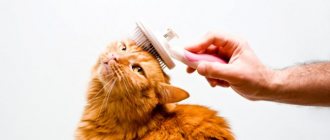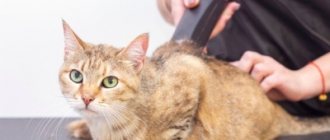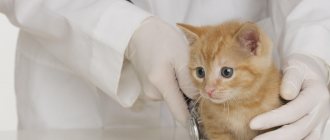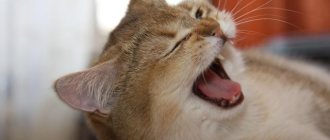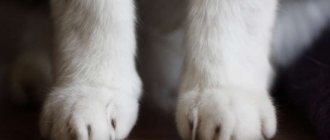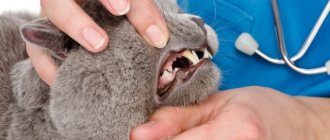The inflammatory process in a cat's gum tissue is called gingivitis. It can affect the gum tissue around one tooth or spread throughout the mouth. Pathology precedes the development of periodontal disease and stomatitis (inflammation of the mucous membranes of the mouth, including the pharynx). The main factors for recovery are timely detection of the disease and prevention of plaque and tartar in the pet.
Our article will help you identify the symptoms of gingivitis in a cat at home. You will learn about the details of diagnosing the disease and subsequent treatment of the animal with medications, medical procedures and folk remedies.
Gingivitis in cats
Veterinary practice shows that animals quite often suffer from damage to their gums and teeth. Gingivitis in cats is one of the most common diseases today. Statistics show that cats over 5 years of age are most susceptible to this disease. Gingivitis is extremely rare in young animals.
Inflammation of the gums of any complexity, which has spread to more than one tooth, is classified as gingivitis. The danger of the disease lies in the possibility of infection of the ligaments of bone tissue, and, as a result, their destruction. Untreated gingivitis in a cat in a timely manner will most likely lead to the loss of all the animal’s teeth.
Tartar
In fact, tartar is the same plaque, which is a colony of microorganisms that has only undergone calcification. It is quite strong and hard, has a brownish tint and is capable of growing.
Symptoms:
- Finding dark yellow or brown growths on your cat's teeth.
- The appearance of bad breath.
- Bleeding and inflammation of the gums.
- Soreness may appear, the cat may begin to eat poorly, or even lose its appetite.
Treatment:
1. Grinding of teeth with a special paste. Used at the initial stage of the disease.
2. Tartar removal: mechanical or ultrasonic.
============================================================================================================================================================================================
Reasons for appearance
There are many causes of gingivitis in cats. However, the main cause of the lesion is the elementary absence or lack of oral hygiene procedures. Once you have a pet in your home, you need to teach it to brush its teeth. Otherwise, your pet will have problems with gums and teeth. Other causes of the occurrence and development of gingivitis are:
- diseases of the immune system;
- unbalanced diet;
- avitaminosis;
- microdamage on the gums;
- malocclusion;
- diseases of the stomach and intestines;
- damaged tooth enamel.
When gum redness is a physiological norm
There is only one exception, when the pet's gums change color and do not require veterinary care, but supervision by both the owner and the veterinarian is required. Redness of the gums, caused by their irritation, can normally only occur in kittens during the period of changing teeth - up to 6 months. However, it is moderate in nature, localized in the area of teeth undergoing physiological replacement, and never completely covers all the arcades - since the timing of the change differs for different teeth.
The swelling is also moderate, and there is no pronounced overhang of the gums. There are no purulent discharges, as well as filmy deposits of fibrin, ulcerative defects on the surface of the mucous membrane. But despite the fact that this process is a physiological norm, experienced breeders pay maximum attention to the kitten during this period of life, since teething is a real test for the pet’s immune system, as well as a crucial period for the formation of correct dentition and bite, which will subsequently ensure effective chewing and the appearance of the pet’s face, characteristic of its breed. The kitten needs to monitor the timing of teething, the absence of conflict between them, monitor the condition of the oral mucosa and carefully clean it.
When changing teeth, the redness of the gums is moderate.
Breeds Predisposed to Gingivitis
There are a number of breeds that are predisposed to developing gingivitis:
- British;
- Persian;
- Burmese;
- Siamese;
- Abyssinian;
- Bengali;
- Maine Coon.
Gingivitis in these breeds occurs due to the breed's structural features of the skull, and therefore the jaws, for example, in brachycephalic cats.
Maine Coons have a hereditary predisposition to gingivitis
Symptoms of gingivitis in cats
With careful attention to the pet, the owner can detect the disease at an early stage at home. The first symptom of the development of gingivitis in a cat is the presence of an unpleasant odor from the mouth. Animals suffering from this disease may notice increased salivation. Examination of your pet's mouth will reveal the presence of swollen gums and a red edging along the tooth line.
The above symptoms of gingivitis in cats may not be detected in a timely manner if, for example, the owner does not have close contact with his pet. It is still necessary to constantly monitor the behavior of the pet, since cats are often able to endure pain in silence, while the disease will destroy their health. If the cat refuses to eat and drink, and its activity has noticeably decreased, we can talk about the progression of gingivitis and its transition to a serious stage.
Thus, the main symptoms of gingivitis in cats are:
- stale animal breath;
- increased salivation;
- red edging on gums;
- swelling of the gums;
- refusal of food and drink;
- little activity.
Diagnosis of gingivitis
Often, a visual examination of the animal’s oral cavity is sufficient to make a primary diagnosis. If inflammation is detected in the cat’s mouth, the animal should be immediately shown to a doctor. If you ignore the problem, some parts of the jaw may be destroyed and even fractured.
For effective treatment, it is important to determine the cause of gingivitis. To begin with, the veterinarian will check the oral cavity for the presence of tartar, redness of the gums, swelling, bleeding gums, and the presence of ulcers. Some symptoms of gingivitis are similar to those of stomatitis. For effective treatment, the doctor must accurately determine the disease.
The following tests may be needed to make a diagnosis:
- biopsy of inflamed tissue;
- X-ray of the jaw;
- analysis to detect leukemia or immunodeficiency;
- Ultrasound of internal organs.
A general blood and urine test for gingivitis is rarely done, since in most cases they are useless. In the acute form, they will help determine the extent of inflammation.
We recommend the article: What can cause bumps on the neck of cats?
Types of gingivitis in cats
There are several types of gingivitis in the cat breed:
- dental gingivitis;
- juvenile gingivitis;
- plasmacytic-lymphocytic gingivitis (autoimmune gingivitis).
Dental gingivitis
Gingivitis can be caused by lack of oral hygiene. In this case, plaque forms on the cat’s teeth, which, in turn, causes inflammation of the gums. This form of gingivitis is called dental gingivitis. This type of disease is the easiest, as it is easier to treat than all other forms. Relapses of the disease practically do not occur after proper treatment.
Juvenile gingivitis
There is a special form of gingivitis that affects young cats during puberty - juvenile gingivitis. The disease occurs as a result of hormonal imbalances, as a result of which the body's internal defenses weaken. This state of affairs provokes the proliferation of harmful bacteria in the oral cavity, which leads to gum inflammation. Juvenile gingivitis can be cured completely if detected early and treated correctly.
Plasmacytic-lymphocytic gingivitis
The most severe form of gingivitis is plasmacytic-lymphocytic gingivitis. In this form of the disease, inflammation affects the entire oral cavity, inflammation is localized on the root of the tongue, cheeks, tongue, larynx and nasopharynx. External manifestations – the pet refuses to eat and drink, due to the fact that plasmacytic gingivitis in cats causes severe pain.
To date, there is no accurate information about the causes of this form of the disease. It is assumed that lymphocytic gingivitis in cats may be caused by deeper health problems - rhinotracheitis, calceviruses, panleukopenia viruses. Due to the etymology of this form of gingivitis in cats, this type of disease is also called autoimmune gingivitis. Autoimmune gingivitis in cats can be cured, but it must be understood that treatment will take a long time and must be started immediately.
Pictures and videos
Figure 1. “Gingivitis”
Figure 2. “Red border with gingivitis”
Figure 3. “Lymphocytic gingivitis”
Figure 4. “Ulcerative gingivitis”
Treatment
Whatever form of the disease is detected in your pet, treatment for gingivitis in cats must begin immediately. Methods of treating this disease directly depend on the form of the disease. If a pet is diagnosed with gingivitis in the early stages, the owner can get by with home treatment. If the animal has more serious forms of the disease, you should immediately contact a veterinarian.
If a visual examination of the pet's oral cavity shows a small amount of swelling and redness, the owner can take home treatment methods.
These methods include:
- oral hygiene – careful brushing of teeth and rinsing with herbal infusions;
- treatment of inflammation - application of Miramistin spray to the affected areas;
- treatment of gums with dental gels - veterinary gels (Dentavedin) or human gels (Metrogil Denta).
More serious forms of gingivitis require treatment under the full supervision of a veterinarian. Treatment, as a rule, begins with sanitation of the oral cavity, followed by the prescription of therapy, which includes taking medications.
Drug therapy includes:
- painkillers;
- antibiotics;
- dietary ration;
- corticosteroid ointments.
Veterinary practice shows that treatment of advanced forms of gingivitis, such as the lymphocytic-plasmacytic form, includes surgical intervention, since most of the animal’s teeth are already affected and need to be removed.
Often, in the treatment of even advanced forms of gingivitis, human immunostimulating drugs help pets. For example, veterinarians advise owners to give interferon to a cat with gingivitis. Thanks to its immunostimulating properties, interferon helps the cat's body fight the invasion of viruses. In this regard, the drug is often used to treat gingivitis. Positive results from the use of the drug were noted not only by veterinarians, but also by pet owners.
When red gums are a sign of disease
If your pet has passed the period of changing teeth, but the gums are red, this indicates the development of gingivitis, which can have various causes.
What symptoms require immediate contact with a veterinarian?
You should contact a veterinarian for any manifestations of gingivitis, since it can be either an independent pathology or indicate the development of an infectious disease or a severe metabolic disorder in your pet. The nature of gingivitis should be clarified even if there are no other symptoms of a general disease, since different types of gingivitis require different treatments, and even therapy for one type of gingivitis often involves different regimens depending on the severity of the process.
In all cases of detection of redness, consultation with a veterinarian is necessary.
Prevention
It is possible to prevent the occurrence of gingivitis in cats only by treating your beloved pet carefully and with care.
Preventive measures include:
- regular oral hygiene – brushing teeth;
- introduction of special foods into the diet that help eliminate plaque;
- purchasing special toys for chewing;
- exclusion from the diet of foods containing small bones.
The lymphocytic-plasmacytic form of gingivitis is an autoimmune disease, and therefore this form of the disease cannot be prevented. To prevent the disease, in this case, all owners are recommended to regularly inspect the animal’s mouth, carry out hygiene procedures and monitor their pet’s nutrition.
At first glance, gum inflammation is a fairly harmless disease in animals that does not threaten their lives. However, gingivitis can take more serious forms and cause the animal not only discomfort, but also severe pain. It is important that the owner treats his pet carefully, because this is the only way to protect him from the disease.

